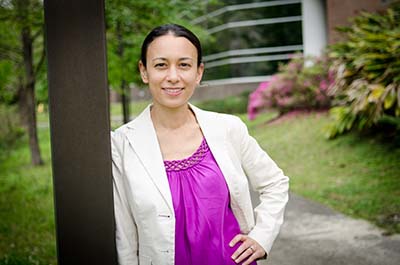Gainesville Sun
By Deborah Strange
UF’s Student Summer Training Program allows rising seniors in high school to work alongside researchers in various labs.
Of all the things 17-year-old Kelly Tran could do this summer, she came from California to work in a University of Florida research lab.
The Irvine High School student is one of 90 students participating in the 60th Student Science Training Program, originally funded by the National Science Foundation and now funded by donors and organizations.
It’s a seven-week program that brings rising high school seniors to UF to get hands-on research experience in different fields, including biology, chemistry, veterinary medicine and biomedical engineering.
Tran is working in assistant professor Blanka Sharma’s biomedical engineering lab to examine the mechanical properties of hydrogel in order to develop three-dimensional tumor models. Saagar Patel, 17, from Seminole High School in Sanford, is also working in the lab through SSTP, studying manganese dioxide particles.
“What you get in a very controlled classroom or classroom lab isn’t necessarily the same as being in an actual research environment,” Sharma said.
Sharma’s lab examines tissue repair and regeneration and delivery systems, specifically in cancer and tumor shrinkage.
SSTP gives high school students an idea of what being a research scientist is like and gives labs extra help during the summer, she said.
It also allows graduate students and professors the chance to mentor students, and it reminds them why they entered their field — “anything that makes you recall why you’re doing what you’re doing,” she said.
Patel said working on a university research project was an opportunity to explore his goal of becoming a doctor. He’s considering trying to continue the research back at school for his science fair.
Tran, who said she wants to experience being away from her California home before deciding where she wants to go to college, wanted to explore more biology.
“I love everything: the animal aspect, the human aspect, the molecular level,” she said.
She said at first she was intimidated by joining the lab because “I’m working with people who have been studying this way more years than I have,” she said.
Shreedevi Kumar, a first-year doctoral student working in the lab, said Tran’s and Patel’s questions bring her and the other lab workers back to research fundamentals. Instead of assuming things, she and her peers in turn make their research more rigorous.
Participating high school students must submit essays, teacher recommendation letters, test scores and resumes in their applications. About 400 students applied for this year’s 90 spots, said Christy Rodkin, coordinator of youth programs at UF’s Center for Precollegiate Education and Training.
Students work in their labs most of the work week, although they attend interdisciplinary lectures and attend seminars.
“We pack as much as we can in seven weeks,” Rodkin said.
Most students already have research experience, she said.
About 75 faculty members volunteer to mentor the high-schoolers and take them into their lab. Faculty members who receive National Science Foundation grants must ensure their research has a broad impact with the public, and mentoring students is a way to accomplish that.
Patel said working in the Sharma’s lab has set him ahead of the game for his senior year of high school.
“I’ve probably learned more chemistry here than in the past year,” he said.
Editor’s note: This story has corrected the training program’s name.
